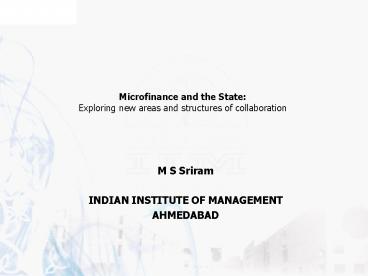M S Sriram PowerPoint PPT Presentation
1 / 18
Title: M S Sriram
1
Microfinance and the StateExploring new areas
and structures of collaboration
- M S Sriram
- INDIAN INSTITUTE OF MANAGEMENT
- AHMEDABAD
2
Part I The Present
- The state has taken several initiatives in the
sector including - Setting up of the Rashtriya Mahila Kosh to
re-finance microfinance activities of NGOs - Encouraging NABARD to set targets for the
self-help group (SHG) Bank linkage programme - Emergence of SIDBI through its Sidbi Foundation
for Micro-Credit as a major financier of
microfinance institutions
3
Part I The Present
- The policy pronouncements of the Reserve Bank of
India from time to time such as - including lending to SHGs as a part of priority
sector targets, - exempting section 25 companies doing microfinance
activities from registering as NBFCs under the
new regulation - permitting the establishment of local area banks
(now withdrawn)
4
Part I The Present
- Routing some of the poverty oriented schemes
through the medium of microfinance (SGSY) - The close linkage built by DWCRA schemes
- The initiatives of various state governments in
promoting schemes such as Swa-Shakti (Gujarat),
Stree-Shakti (Karnataka) Velugu (Andhra Pradesh)
5
Part II Performance of the mainstream sector
- Commercial Banks
- Improvement in priority sector lending - but
growth seen in other priority sectors, marginal
growth in agriculture - Targets set for weaker sections not achieved by a
small margin in public sector banks. The
achievements of private sector banks nowhere near
targets - NPAs in priority sector at 20, while overall
NPAs around 12
6
Part II Performance of the mainstream sector
- Regional Rural Banks
- Turnaround in overall performance
- Low deployment of credit - CD Ratio of 42 as
against the commercial bank CD Ratio of 60 - NPAs improving - is it because they are not
lending as much? - Growth of deposits faster than loans - possibly
providing useful financial services to the poor -
an outlet for their savings.
7
Part II Performance of the mainstream sector
- Regional Rural Banks
8
Part II Performance of the mainstream sector
- Co-operatives
- State Co-op Banks - performance improving but
high level of NPAs 17 - The performance of lower tiers is Worse - a third
of the CCBs are making losses. Overall level of
NPAs is 33 - The performance of PACS is nowhere near
desirable. Capital adequacy a problem in both
CCBs and PACSs - LT Credit structure is in extended state of
sickness
9
Part I The Present
10
Part II Performance of the mainstream sector
- Other schemes promoted by the State
- DRI still in place, but banks unable to achieve
targets - SGSY partly routed through SHGs. 40 disbursement
to women under SGSY. Scheme much better than
IRDP, but still could do with some toning up - KCC is being extended to levels less than
Rs.5,000. Penetration to be achieved - SHG Linkage programme growing fast, but still has
a miniscule share in the overall rural credit
market
11
Part III Understanding the dynamics of State
Involvement in Development schemes
- Channels
- implement schemes through own agencies
- route schemes through banks
- route schemes through NGOs
- Each of the above have their own dynamics
12
(No Transcript)
13
Part IV New Areas for involvement of the State
- Direct Involvement
- Given the dynamics it would become more and more
difficult for the state to directly involve
itself in this sector in an effective manner - State agencies are not oriented to implement
aspects relating to financial services in a
sustainable and profit-oriented manner - However the state can still earmark resources to
ensure that it is delivered by professional
agencies in an effective manner
14
Part IV New Areas for involvement of the State
- Incentivisation
- Earmark resources in a manner that commercial
banks explore collaborations and involve
themselves in channeling resources to the poor.
Lessons from the structuring of returns on RIDF
investments can be used.
- Regulation
- Create a legal framework so that NGO promoted
microfinance institutions can work effectively.
Recognise that microfinance is much beyond SHGs. - Ensure that entry barriers are minimal for loan
companies and increase restrictions as
sophistication of services increase.
15
Part IV New Areas for involvement of the State
- Incentivisation
- Set up a risk incentive fund for mainstream
institutions. - Design the fund to increase target areas such as
- increase in number of small borrowal accounts,
increase in penetration to weaker sections - Reward on the basis of overall recovery
performance
- Regulation
- Create scope for an intermediary level financial
institution with lower capital requirements and
have phased capital requirements for additional
services to be offered. - Provide for membership based financial service
organisations to function under the companies act
(like the producers companies)
16
Part IV New Areas for involvement of the State
- Interrospection
- Allow for better usage of existing infrastructure
- primary co-ops, bank branches in rural areas -
if they could be managed strategically in
collaboration with private sector or NGOs,
leveraging of infrastructure and outreach is
possible
- Regulation
- Harmonise the working of RRBs and sponsor banks.
- Allow for change of ownership of RRBs, Merger of
RRBs with each other for cross subsidisation,
risk mitigation and economies of scale - with the
proviso that outreach will not be compromised - Permission for closure of loss making RRB
branches to be examined very carefully.
17
Summary
- Reduced direct involvement
- Increased outlays
- Structuring of outlays and finding right outlets
- Creating incentives and regulatory environment
for implementation
18
Thank You

